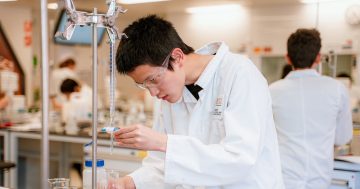
Jameson and Violet from Charles Conder Primary School present their project on space debris at the showcase. Photo: James Day.
They say childhood ambitions are the paths in life that will truly satisfy you. While many aren’t so lucky in following through on their dreams, there is hope for a few of the next generation to make theirs come true.
Kids in Space, which began earlier this year, has been showing primary school children around the country what opportunities await them in Australia’s growing space industry.
Eight schools in the ACT were chosen for the national education program brought together by the Andy Thomas Space Foundation, Australian Space Agency and Makers Empire. And on Thursday (27 July) at the Hedley Beare Centre for Teaching and Learning, the children showed off what they’d made over the past two months as part of the program.
Program organiser Makers Empire, an education-focused technology start-up, creates 3D design software to help schools teach their students. Its CEO Johnathan Soong says the group helps open the eyes of the next generation.
“A lot of kids and teachers don’t even realise there’s a space industry in Australia,” he says. “Even in Canberra where they might be driving past the buildings of these space companies every day.
“This program has been really good for them to learn about what’s happening and the opportunities available to them later on when they’re choosing what to study.”

Using the Makers Empire app, students designed and printed out 3D models of the machines. Here you can see the full waste management process for these devices coming out of Earth’s orbit. Photo: James Day.
Members of space industry heavyweights, including the Australian Space Agency, Lockheed Martin, Airbus and KBR, also joined the high-flying program. As event judges, they were tasked to choose the winning team – Kingsford Smith School – who will represent the Territory in Adelaide for the national showcase at the Space Discovery Centre.
Mr Soong says the program helps students master the art of using this technology through ‘Design Thinking’.
“There’s a whole field of research into how it develops a person’s spatial ability, which is the capacity to understand, reason and remember the visual and spatial relations among objects or space,” he says.
“This is why – to implement the idea – we use 3D printing instead of paddle pop sticks, cardboard and masking tape. It gets the kids to learn and think in an abstract way, which is a great help for them later in life.
“But if there was one way we could improve the program, it would be to combine the two things kids love the most. Dinosaurs and space.”





















